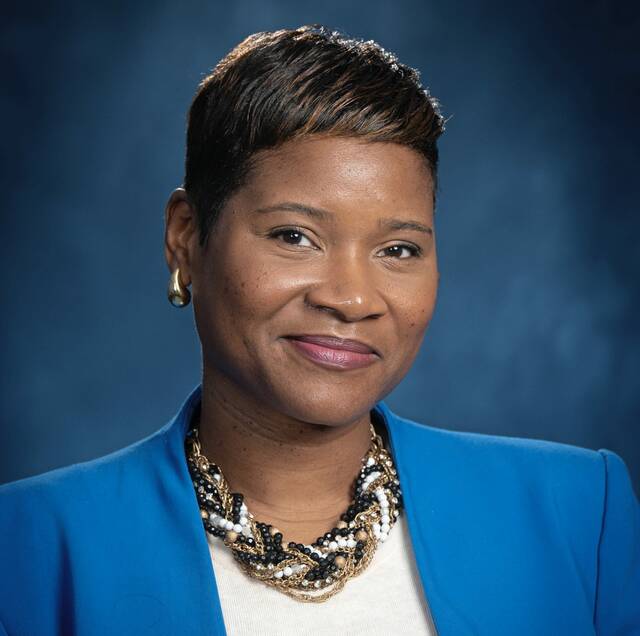https://triblive.com/business/united-steelworkers-elects-1st-woman-president/
United Steelworkers elects its 1st woman president

The United Steelworkers union, a Pittsburgh-based giant of organized labor, has selected its next leader.
International Vice President Roxanne Brown secured the presidency in a unionwide election, the United Steelworkers announced Friday.
Brown, a Black woman, is the 10th person to hold the top job — and the first who’s not a white man.
She was the sole nominee for international president in an election process that started in June and stretched into the fall. Her four-year term as head of the 850,000-member union starts March 1.
Brown’s early days as international president promise tough contract negotiations and a less-than-friendly regulatory landscape.
Collective bargaining agreements at U.S. Steel, Cleveland-Cliffs, Marathon, Goodyear and Arconic are all up next year.
And the National Labor Relations Board, the final authority on any disputes that might arise, has been paralyzed under the Trump administration.
“The uncertain environment created by this administration is going to make bargaining good, strong contracts even more necessary — and harder,” Brown told TribLive.
She takes over for David McCall, who was promoted in 2023 after the death of his predecessor, Tom Conway. McCall did not seek election this fall.
“I can think of no one better qualified to lead our union as we navigate this unprecedented era of largely unchecked corporate greed,” McCall said in a statement.
When he took the reins, McCall had more than 40 years of experience with the United Steelworkers, starting as a millwright and working his way up to international president.
A new energy
Brown, by contrast, is a 47-year-old policy guru with her fingerprints on federal manufacturing, environmental and energy law. Her first role with the union came in 2007, when she was brought on as assistant legislative director.
“I think she will bring an energy the union has needed,” said Kate Bronfenbrenner, director of labor education research at Cornell University’s School of Industrial and Labor Relations. “It seems for a lot of unions, by the time you get to the position where you’re going to be president, you’re an older generation.”
Brown’s upcoming promotion also reflects the union’s trend toward a younger, more diverse membership base, Bronfenbrenner said.
Amber Miller, director of the union’s Rapid Response network, will take over for Brown as international vice president.
District 10 Director Bernie Hall, who covers Pennsylvania, won reelection.
Bargaining with U.S. Steel
McCall’s legacy is still in the making. But his brief tenure as union boss may be best remembered by his losing effort to stop the U.S. Steel deal. Many workers broke with McCall as the saga unfolded, including a handful of union leaders in the Mon Valley who publicly called for a sale to Nippon Steel.
Brown fully backed McCall’s stance. If there’s a lesson to learn from the sale, in her view, it’s that the union needs to strengthen its internal messaging on acquisitions.
She’s now looking ahead to contract talks with U.S. Steel next summer. Nippon has promised to invest more than $2 billion in the outdated Mon Valley Works.
“They took great pains to convince our folks in the Mon Valley about investments that were coming their way,” Brown said. “And I think a big part of those negotiations will be holding their feet to the fire on those investment commitments and making sure those happen.”
Tariffs
The United Steelworkers finds itself in a delicate position on U.S.-Canada trade talks, which stalled this week after President Donald Trump took offense to a Canadian political advertisement.
About 225,000 of the union’s members are in Canada. So, when U.S. workers cheer certain tariffs — say, the 50% import tax on Canadian steel — the United Steelworkers can’t just join in.
Brown said the union worked to nudge the first Trump administration toward less restrictive trade policies.
“This time around, we have not been as successful,” Brown said. “But our position has not changed: Canada is not our enemy.”
Chances to grow
Brown jokes she’s in a “cradle to grave union,” with members ranging from nurses to gravediggers. In between are traditional, blue collar union members — like steel workers and tire makers — but also a substantial number of white collar workers.
One of the United Steelworkers’ largest locals contains more than 10,000 Kaiser Permanente health care workers in California.
In an intersection of the two worlds, Brown sees one of the union’s best chances to grow. She expects the artificial intelligence boom to drive demand for miners and the metals they extract.
The union will have to keep growing its ranks or risk losing influence, according to Bronfenbrenner, the Cornell professor, since many of its core sectors are shrinking.
Brown is open to just about any chance to add members.
“We are a union that touches every single aspect of the United States economy,” she said. “And so, for us, that creates kind of a unique opportunity to look across all of those sectors.”
Copyright ©2025— Trib Total Media, LLC (TribLIVE.com)
